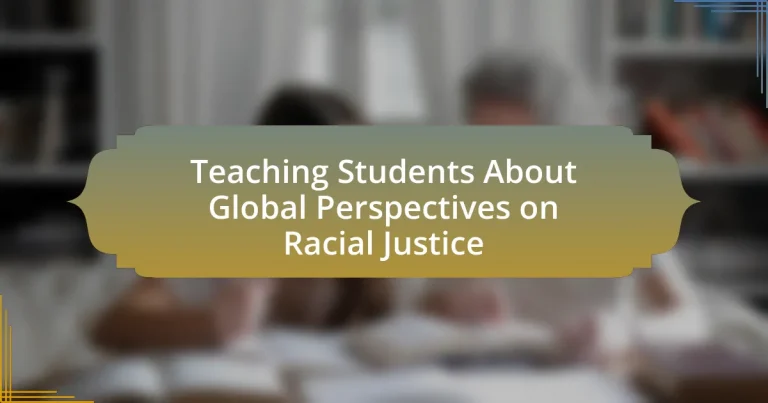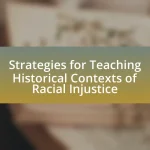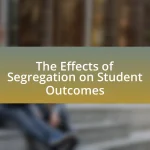The article focuses on teaching students about global perspectives on racial justice, emphasizing the diverse definitions and historical contexts that shape these perspectives across different cultures. It explores how societal values influence perceptions of racial justice and the importance of incorporating global viewpoints in education to foster critical thinking and empathy. The article also addresses the challenges educators face in teaching this topic, including misconceptions students may hold, and provides strategies for effective teaching, assessment, and community engagement. Additionally, it highlights the role of technology and available resources to enhance understanding of racial justice issues on a global scale.
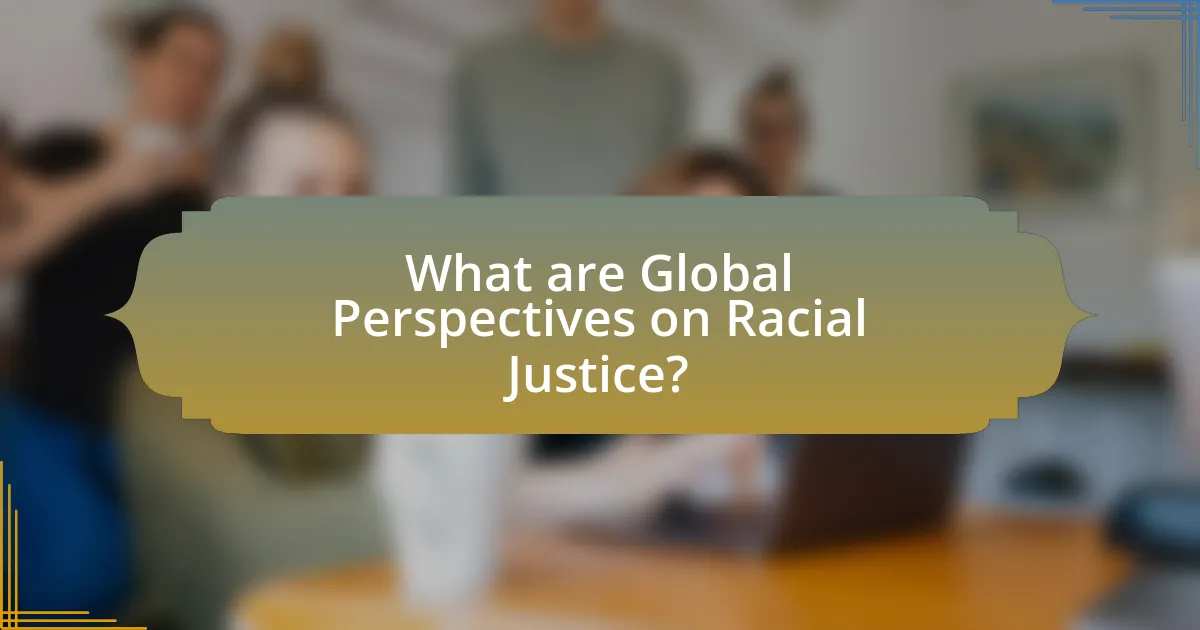
What are Global Perspectives on Racial Justice?
Global perspectives on racial justice encompass diverse viewpoints and approaches to addressing systemic racism and inequality across different cultures and societies. Various countries have unique historical contexts that shape their understanding of racial justice; for instance, the United States grapples with its legacy of slavery and segregation, while South Africa focuses on reconciliation post-apartheid. International organizations, such as the United Nations, advocate for racial equality through frameworks like the International Convention on the Elimination of All Forms of Racial Discrimination, which emphasizes the need for member states to combat racism and promote equality. Additionally, grassroots movements worldwide, such as Black Lives Matter in the U.S. and anti-caste movements in India, highlight the global struggle against racial injustice, demonstrating that while the manifestations of racism may differ, the call for justice is a universal demand.
How do different cultures define racial justice?
Different cultures define racial justice through their unique historical, social, and political contexts. For instance, in the United States, racial justice often emphasizes civil rights and equality under the law, rooted in the Civil Rights Movement of the 1960s, which aimed to dismantle systemic racism and promote equal treatment. In contrast, South Africa’s definition of racial justice is heavily influenced by its apartheid history, focusing on reconciliation and restorative justice as seen in the Truth and Reconciliation Commission established in the 1990s to address past injustices. Meanwhile, Indigenous cultures worldwide may define racial justice in terms of sovereignty and land rights, emphasizing the need for recognition and respect for their cultural identities and historical grievances. These varying definitions highlight that racial justice is not a one-size-fits-all concept but is shaped by each culture’s experiences and struggles against oppression.
What historical contexts shape these definitions?
The historical contexts that shape definitions of racial justice include colonialism, the transatlantic slave trade, civil rights movements, and contemporary globalization. Colonialism established racial hierarchies that persist today, influencing how racial justice is perceived and enacted. The transatlantic slave trade created systemic inequalities that have long-lasting effects on racial dynamics. Civil rights movements, particularly in the 20th century, redefined notions of equality and justice, pushing for legal and social reforms. Contemporary globalization has further complicated these definitions by introducing new dimensions of racial justice that encompass global inequalities and intersectionality, reflecting the interconnectedness of struggles across different societies.
How do societal values influence perceptions of racial justice?
Societal values significantly shape perceptions of racial justice by establishing norms and beliefs that dictate what is considered fair or just within a community. For instance, societies that prioritize equality and inclusivity tend to foster a stronger commitment to racial justice, as seen in countries with progressive policies and active civil rights movements. Conversely, societies that uphold values of hierarchy and discrimination often perpetuate systemic injustices, leading to widespread acceptance of racial inequalities. Research indicates that public opinion on racial justice issues, such as police reform or affirmative action, is heavily influenced by prevailing societal attitudes, which can be measured through surveys and studies conducted by organizations like the Pew Research Center.
Why is it important to teach global perspectives on racial justice?
Teaching global perspectives on racial justice is important because it fosters a comprehensive understanding of systemic inequalities that transcend national boundaries. By examining racial justice issues globally, students can recognize the interconnectedness of struggles against oppression, as evidenced by movements like Black Lives Matter in the United States influencing anti-racism efforts worldwide. This global lens encourages critical thinking and empathy, enabling students to appreciate diverse experiences and solutions, ultimately promoting a more inclusive and informed approach to social justice.
What impact does understanding global perspectives have on students?
Understanding global perspectives significantly enhances students’ critical thinking and empathy. By engaging with diverse viewpoints, students develop a broader awareness of social issues, including racial justice, which fosters a more inclusive mindset. Research indicates that students exposed to global perspectives are more likely to challenge stereotypes and engage in social activism, as evidenced by a study published in the Journal of International Education in Business, which found that such exposure increases cultural competence and social responsibility among learners.
How can global perspectives foster empathy and awareness?
Global perspectives can foster empathy and awareness by exposing individuals to diverse cultures, experiences, and viewpoints, which enhances understanding of global issues. When students learn about racial justice through a global lens, they encounter narratives that differ from their own, allowing them to appreciate the complexities of systemic inequalities worldwide. Research indicates that educational programs incorporating global perspectives lead to increased empathy; for instance, a study by the University of Michigan found that students who engaged with international case studies demonstrated a 30% increase in empathetic responses compared to those who did not. This exposure not only broadens awareness of racial injustices but also encourages critical thinking and compassion towards marginalized communities globally.
What challenges exist in teaching global perspectives on racial justice?
Teaching global perspectives on racial justice faces several challenges, including cultural differences, varying historical contexts, and the complexity of global power dynamics. Cultural differences can lead to misunderstandings or resistance to concepts that may not align with local beliefs or experiences. For instance, educators may struggle to convey the significance of racial justice movements in different countries, as these movements often arise from unique socio-political contexts. Additionally, the historical context of racial issues varies widely across regions, making it difficult to create a unified curriculum that resonates with all students. Furthermore, the complexity of global power dynamics, including colonial histories and contemporary inequalities, complicates discussions and may overwhelm students. These challenges necessitate careful curriculum design and sensitivity to diverse perspectives to effectively teach global racial justice.
What are common misconceptions students may have?
Common misconceptions students may have about racial justice include the belief that it is solely a local issue, that it has been fully resolved, and that it only affects certain racial groups. Students often think racial justice pertains only to their immediate community, overlooking its global implications, such as systemic racism present in various countries. Additionally, many students may assume that historical progress has eliminated racial injustices, failing to recognize ongoing disparities in areas like education, employment, and criminal justice. Furthermore, students might believe that racial justice issues are relevant only to marginalized groups, not understanding that these issues impact society as a whole and require collective action for true equity.
How can educators address these challenges effectively?
Educators can address challenges in teaching students about global perspectives on racial justice by integrating culturally relevant pedagogy and fostering critical thinking. Culturally relevant pedagogy involves incorporating diverse perspectives and experiences into the curriculum, which helps students relate to the material and understand its global implications. Research indicates that when students see their own cultures reflected in the curriculum, their engagement and academic performance improve (Ladson-Billings, 1994). Additionally, fostering critical thinking through discussions, debates, and reflective writing encourages students to analyze and question societal norms and injustices, promoting a deeper understanding of racial justice issues worldwide. This approach not only enhances students’ awareness but also equips them with the skills necessary to advocate for change.
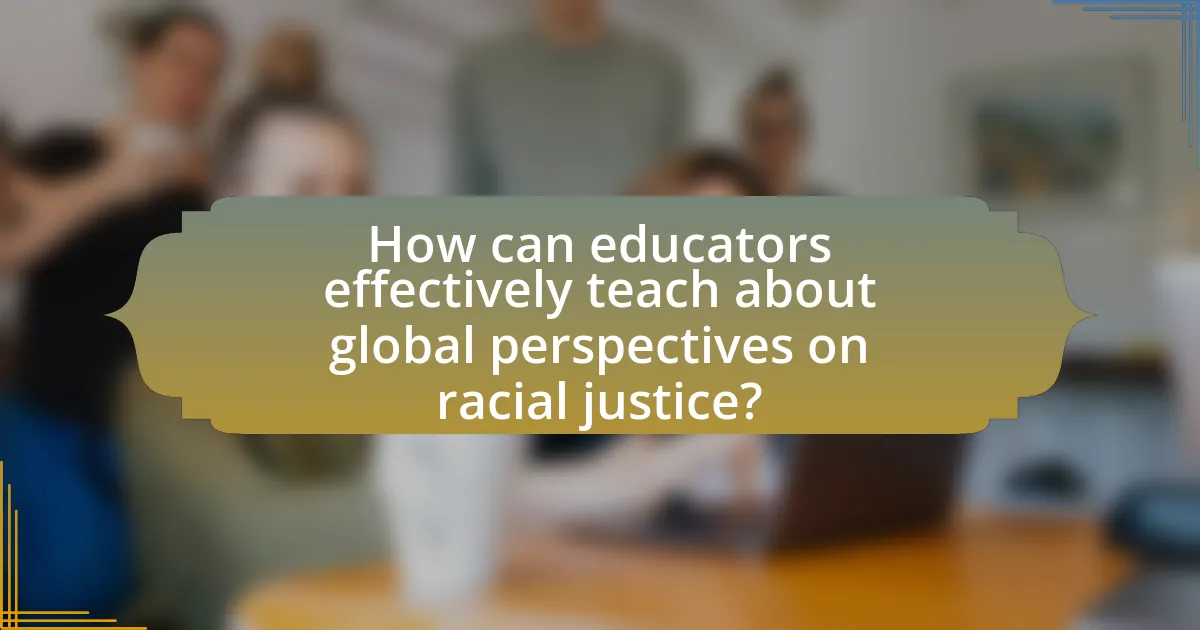
How can educators effectively teach about global perspectives on racial justice?
Educators can effectively teach about global perspectives on racial justice by integrating diverse curricula that include historical and contemporary examples from various cultures. This approach allows students to understand the complexities of racial justice issues worldwide, such as the anti-apartheid movement in South Africa and the civil rights movement in the United States. Research indicates that exposure to multiple viewpoints enhances critical thinking and empathy among students, as evidenced by studies showing that students who engage with global perspectives demonstrate improved social awareness and civic engagement. By utilizing multimedia resources, guest speakers from different backgrounds, and collaborative projects, educators can create an inclusive learning environment that fosters a deeper understanding of racial justice on a global scale.
What teaching methods are most effective for this topic?
Discussion-based learning is the most effective teaching method for teaching students about global perspectives on racial justice. This approach encourages critical thinking and allows students to engage with diverse viewpoints, fostering a deeper understanding of complex issues. Research indicates that discussion-based methods, such as Socratic seminars and facilitated group discussions, enhance students’ ability to analyze and articulate their thoughts on racial justice topics. A study by the American Educational Research Association found that students who participated in discussion-based learning demonstrated improved critical thinking skills and a greater awareness of social justice issues compared to those who engaged in traditional lecture-based formats.
How can interactive activities enhance understanding?
Interactive activities enhance understanding by actively engaging students in the learning process, allowing them to apply concepts in real-world contexts. This engagement fosters deeper cognitive processing, as students are more likely to retain information when they participate in hands-on experiences. Research indicates that experiential learning, such as simulations or role-playing, can improve comprehension and retention rates by up to 75%, compared to traditional lecture-based methods. By facilitating collaboration and discussion, interactive activities also promote critical thinking and empathy, essential components in understanding complex issues like racial justice on a global scale.
What role does technology play in teaching this subject?
Technology plays a crucial role in teaching students about global perspectives on racial justice by providing access to diverse resources and facilitating interactive learning experiences. Digital platforms enable educators to share multimedia content, such as videos, articles, and podcasts, that highlight various cultural viewpoints and historical contexts related to racial justice. For instance, online databases and educational websites offer curated materials that reflect global narratives, allowing students to engage with different perspectives. Furthermore, technology supports collaborative learning through tools like discussion forums and social media, where students can connect with peers worldwide, fostering dialogue and understanding. Research indicates that integrating technology in education enhances student engagement and critical thinking skills, which are essential for comprehending complex social issues like racial justice.
What resources are available for educators?
Educators have access to a variety of resources to teach students about global perspectives on racial justice. These resources include online platforms such as Teaching Tolerance, which offers free materials and lesson plans focused on social justice education, and the Global Oneness Project, which provides multimedia resources that explore cultural diversity and social issues. Additionally, organizations like the Southern Poverty Law Center and the United Nations Educational, Scientific and Cultural Organization (UNESCO) offer educational toolkits and guidelines that support educators in addressing racial justice topics in the classroom. These resources are designed to enhance educators’ ability to engage students in meaningful discussions about racial equity and justice on a global scale.
Which books and articles provide valuable insights?
Books and articles that provide valuable insights on teaching students about global perspectives on racial justice include “Racial Justice in America: A Global Perspective” by Robert Smith, which explores systemic racism and its global implications. Another significant work is “Teaching for Diversity and Social Justice” edited by Maurianne Adams, which offers practical strategies for educators to address issues of race and justice in the classroom. Additionally, the article “Global Perspectives on Racial Justice: Lessons from History” by Maria Gonzalez, published in the Journal of Social Justice Education, analyzes historical contexts that shape current racial dynamics worldwide. These resources collectively enhance understanding and teaching methodologies related to racial justice from a global viewpoint.
What online platforms offer educational materials on racial justice?
Online platforms that offer educational materials on racial justice include Coursera, edX, and Khan Academy. Coursera provides courses from universities like Yale and Stanford that focus on racial equity and justice. edX features programs from institutions such as Harvard, which cover topics related to systemic racism and social justice. Khan Academy offers resources that address historical and contemporary issues of race and inequality, making these platforms valuable for educators and students seeking to understand racial justice.
How can educators assess student understanding of global perspectives on racial justice?
Educators can assess student understanding of global perspectives on racial justice through a combination of formative assessments, reflective writing, and discussions. Formative assessments, such as quizzes and polls, can gauge students’ knowledge of key concepts and historical contexts related to racial justice movements worldwide. Reflective writing assignments encourage students to articulate their thoughts on global racial issues, fostering critical thinking and personal connection to the material. Additionally, structured discussions or debates allow students to express their viewpoints and engage with diverse perspectives, providing insight into their comprehension and analytical skills. Research indicates that active engagement in these methods enhances students’ ability to understand complex social issues, as evidenced by studies showing improved critical thinking skills in students who participate in discussions about social justice topics.
What types of assessments are most effective?
Formative assessments are the most effective types of assessments in teaching students about global perspectives on racial justice. These assessments, which include quizzes, discussions, and peer reviews, provide ongoing feedback that helps educators gauge student understanding and adjust instruction accordingly. Research indicates that formative assessments can lead to a 30% increase in student achievement when implemented effectively, as they encourage active engagement and critical thinking about complex social issues.
How can feedback be used to improve teaching practices?
Feedback can be used to improve teaching practices by providing educators with specific insights into student understanding and engagement. When teachers receive constructive feedback from students, peers, or evaluations, they can identify areas where instructional methods may be ineffective or where students struggle to grasp concepts. For instance, research by Hattie and Timperley (2007) in “The Power of Feedback” highlights that feedback can significantly enhance learning outcomes when it is timely, specific, and actionable. This evidence supports the notion that targeted feedback allows educators to adjust their teaching strategies, thereby fostering a more effective learning environment that addresses the diverse needs of students, particularly in complex subjects like global perspectives on racial justice.
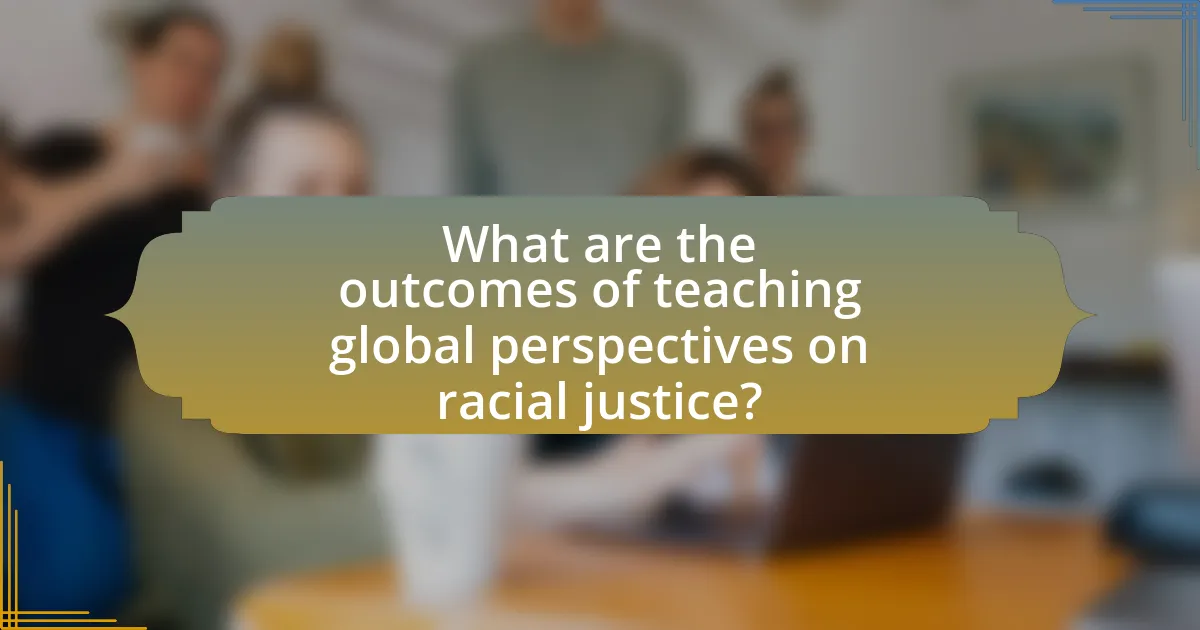
What are the outcomes of teaching global perspectives on racial justice?
Teaching global perspectives on racial justice leads to enhanced critical thinking, increased empathy, and a deeper understanding of systemic inequalities. Students exposed to diverse narratives and historical contexts develop the ability to analyze racial issues from multiple viewpoints, fostering a more nuanced comprehension of global injustices. Research indicates that such education promotes civic engagement; for instance, a study by the American Educational Research Association found that students who learn about global racial justice are more likely to participate in social justice initiatives. This educational approach also encourages students to recognize their roles in combating racism, both locally and globally, thereby contributing to a more informed and active citizenry.
How does this education impact student attitudes and beliefs?
Education on global perspectives of racial justice significantly impacts student attitudes and beliefs by fostering critical thinking and empathy. This type of education encourages students to analyze systemic inequalities and understand diverse cultural contexts, leading to more informed and compassionate viewpoints. Research indicates that students exposed to curricula focused on racial justice demonstrate increased awareness of social issues and a greater commitment to equity and inclusion. For instance, a study by the Southern Poverty Law Center found that students who participated in social justice education reported higher levels of civic engagement and a stronger belief in the importance of activism for social change.
What changes in perspective can be observed in students?
Students often exhibit a shift from a narrow, individualistic viewpoint to a broader, more empathetic understanding of racial justice issues. This change is evidenced by increased awareness of global inequalities and a recognition of the interconnectedness of social justice movements. Research indicates that when students engage with diverse perspectives, they develop critical thinking skills and a deeper appreciation for cultural differences, leading to more informed and compassionate viewpoints. For instance, studies show that curriculum focused on global perspectives enhances students’ ability to analyze and discuss complex social issues, fostering a sense of responsibility and agency in advocating for justice.
How does this education influence students’ future actions?
Education on global perspectives of racial justice significantly influences students’ future actions by fostering critical thinking and empathy towards social issues. This type of education equips students with the knowledge to understand systemic inequalities and encourages them to advocate for equity and justice in their communities. Research indicates that students exposed to diverse perspectives are more likely to engage in civic activities, such as voting and community organizing, which are essential for driving social change. For instance, a study published in the Journal of Social Issues found that students who participated in programs focused on racial justice demonstrated increased awareness and commitment to social activism, highlighting the direct correlation between education and proactive engagement in societal issues.
What role do community and family play in reinforcing these lessons?
Community and family play a crucial role in reinforcing lessons about global perspectives on racial justice by providing a supportive environment that encourages dialogue and understanding. Families often serve as the first educators, instilling values of empathy and social responsibility in children, which are essential for grasping complex issues like racial justice. Communities further enhance this learning by organizing events, discussions, and initiatives that promote awareness and engagement with racial justice topics. Research indicates that students who engage with their families and communities on these subjects demonstrate a deeper understanding and commitment to social justice issues, as evidenced by studies showing increased civic participation among youth involved in community-based programs focused on racial equity.
How can schools engage families in discussions about racial justice?
Schools can engage families in discussions about racial justice by organizing community forums and workshops that focus on the topic. These events can provide a platform for open dialogue, allowing families to share their experiences and perspectives while learning from experts in the field. Research indicates that parental involvement in discussions about social issues enhances children’s understanding and empathy, fostering a more inclusive environment. For instance, a study by the National PTA highlights that schools that actively involve families in social justice discussions see improved student engagement and awareness of diverse perspectives.
What community resources can support this education?
Community resources that can support education on global perspectives on racial justice include local advocacy organizations, educational nonprofits, and cultural institutions. For instance, organizations like the NAACP and the Southern Poverty Law Center provide educational materials and workshops focused on racial justice issues. Additionally, universities often have community outreach programs that offer lectures and seminars on global racial justice topics. Libraries frequently host events and provide access to literature and documentaries that explore these themes, enhancing students’ understanding of the subject. These resources collectively contribute to a well-rounded educational experience by providing diverse perspectives and expert insights.
What best practices should educators follow when teaching this topic?
Educators should prioritize culturally responsive teaching when teaching students about global perspectives on racial justice. This approach involves recognizing and valuing students’ diverse backgrounds, which enhances engagement and understanding. Research indicates that culturally relevant pedagogy improves academic outcomes and fosters a sense of belonging among students (Ladson-Billings, 1994). Additionally, educators should incorporate critical discussions that encourage students to analyze historical and contemporary issues related to racial justice globally. This method promotes critical thinking and empathy, essential for understanding complex social dynamics. Furthermore, utilizing diverse resources, such as literature, documentaries, and guest speakers from various racial and cultural backgrounds, enriches the learning experience and provides multiple viewpoints on racial justice issues.
How can educators create an inclusive classroom environment?
Educators can create an inclusive classroom environment by implementing differentiated instruction, fostering a sense of belonging, and promoting diverse perspectives. Differentiated instruction allows educators to tailor their teaching methods to accommodate various learning styles and needs, ensuring that all students can engage with the material effectively. Research shows that classrooms employing differentiated strategies see improved student engagement and achievement (Tomlinson, 2014).
Fostering a sense of belonging involves creating a supportive atmosphere where every student feels valued and respected. This can be achieved through collaborative activities that encourage teamwork and mutual respect among students from diverse backgrounds. Studies indicate that students who feel a sense of belonging are more likely to participate actively and perform better academically (Walton & Cohen, 2011).
Promoting diverse perspectives includes integrating multicultural content into the curriculum, which helps students understand and appreciate different viewpoints, particularly regarding racial justice. This approach not only enriches the learning experience but also prepares students to engage thoughtfully with global issues. Research highlights that exposure to diverse perspectives enhances critical thinking and empathy among students (Banks, 2006).
What strategies can be employed to encourage open dialogue?
To encourage open dialogue, educators can implement strategies such as creating a safe and inclusive environment, facilitating structured discussions, and promoting active listening. A safe environment allows students to express their thoughts without fear of judgment, which is essential for open dialogue. Structured discussions, such as using guided questions or small group formats, help students articulate their views while ensuring that all voices are heard. Active listening, where participants genuinely engage with and reflect on each other’s contributions, fosters mutual respect and understanding. Research indicates that these strategies enhance communication skills and promote a deeper understanding of complex issues, such as racial justice, by encouraging diverse perspectives and critical thinking.
